Famous Paintings at The Met – The Top Met Museum Highlights
Have you ever wondered what famous pieces of art are at the Metropolitan Museum? It is quite a daunting task trying to pick one’s favorite Met Museum highlights, as there are said to be more than two million Metropolitan Museum of Art artworks on exhibition! It would take days to explore all of the paintings in the Metropolitan Museum of Art in person, so to save you some time, we have compiled a list of the artworks one must see at the Met.
Famous Paintings at the Met Museum
Met artworks are world-renowned, with the famous institution receiving more than a million visitors in 2020 alone. In such large crowds, and with so many to see, very often visitors only get a glimpse at any given painting and never get the chance to examine or understand the work on a deeper level. With so many artworks to choose from, picking the best Metropolitan Museum of Art artworks comes down to a few factors: public opinion, critical reception, and personal taste.
With that in mind, here is our list of famous paintings at The Met Museum.
Venus and the Lute Player (1570) by Titian
| Artist | Tiziano “Titian” Vecelli (1488 – 1576) |
| Date | 1570 |
| Medium | Oil on canvas |
| Dimensions (cm) | 210 cm x 165 cm |
Titian is, without a doubt, one of the most well-known Italian Renaissance artists of all time. Known for his sensuous and seductive images of women, he reigned as Venice’s artist king throughout his lifetime. While all early Renaissance artworks depicted the holy mother of God, later Renaissance artworks began to glorify Venus as the ruling mother of beauty.
Venus is portrayed in this painting, accompanied by her son Cupid and a lute player.

When it came to creating or performing love songs throughout the Renaissance, the lute was the instrument of choice. Titian catches Venus taking a respite from the lute player who is tenderly looking at her in this painting. Cupid honors Venus with a floral wreath at that point.
Nymphs and satyrs may be seen dancing in the background to the music of a shepherd.
Julie Le Brun Looking in a Mirror (1787) by Elisabeth Louise Vigée Le Brun
| Artist | Elisabeth Louise Vigée Le Brun (1755 – 1842) |
| Date | 1787 |
| Medium | Oil on canvas |
| Dimensions (cm) | 73 cm x 59 cm |
Le Brun is regarded as one of the best 18th-century French artists, as well as one of the most significant female artists of all time. She trained herself to paint and was very accomplished. Despite living during the challenging days of the French Revolution, she was a huge success. Elizabeth Le Brun married a renowned Parisian art dealer when she was just 21 years old, and because of his occupation, she was first denied admission to the elite Academie Royale de Peinture et de Sculpture.
Yet, because she knew Queen Marie Antoinette, she was subsequently accepted at the age of 28.

She was compelled to depart France when the French Revolution broke out since she was close to the Queen. She spent some time in Italy before returning to France. This painting is an excellent portrayal of Le Brun’s sole daughter. Le Brun created the same innovative image of her daughter two years prior.
The double imagery plays on illusion versus reality and demonstrates Le Brun’s ability as an artist even more.
The Death of Socrates (1787) by Jacques-Louis David
| Artist | Jacques-Louis David (1748 – 1825) |
| Date | 1787 |
| Medium | Oil on canvas |
| Dimensions (cm) | 130 cm x 196 cm |
Without context and knowledge of the tale, this moving picture will signify practically nothing to the observer. The artwork may, for example, portray a group of ancient individuals enjoying an engaging discourse. At one point, a servant hands a cup of wine to the most important individual in the center. But what that man is offering him is poison hemlock!
Socrates was a controversial philosopher during the Classical period. Plato, his most renowned student, wrote about the murder scene.
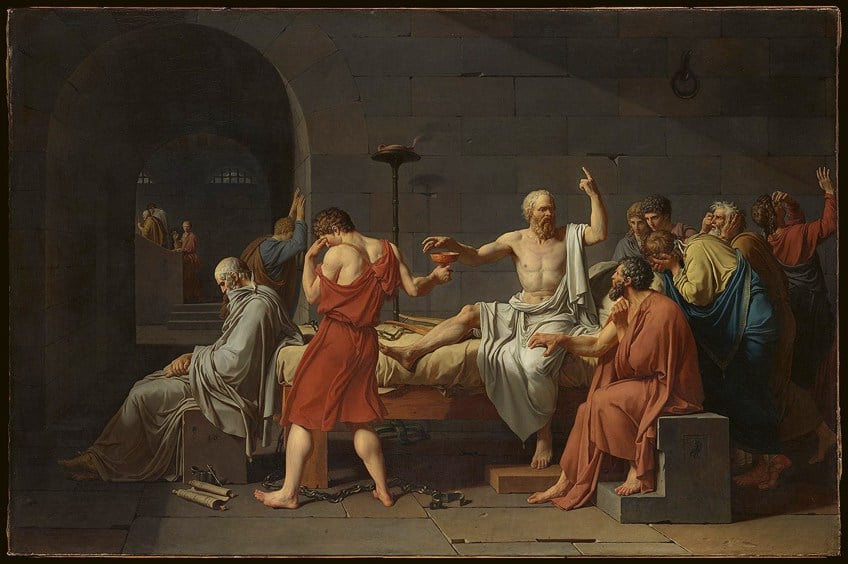
He was condemned to death after being found guilty of impiety. He might have fought against his sentence, but he appeared to die voluntarily by ingesting the poison. Jacques Louis David, the artist, lost his father in a fight. His relatives looked after him, and it was clear that he was gifted in the arts from an early age. During his early artistic career, he faced numerous difficulties and even attempted suicide by starving himself.
He eventually received a scholarship to study in Rome, and that’s when he really started to shine.
Washington Crossing the Delaware (1851) by Emanuel Leutze
| Artist | Emanuel Leutz (1816 – 1868) |
| Date | 1851 |
| Medium | Oil on canvas |
| Dimensions (cm) | 378 cm x 648 cm |
This famous image is often seen as a symbol of American patriotism and is one of the most recognizable paintings in the Metropolitan Museum of Art. However, you may be completely surprised to discover that it was not produced by an American painter in the United States, but by Emanuel Leutze, a German-born artist and that it was painted in the middle of the 19th century in Düsseldorf.
Marshall O. Roberts, a rich industrialist, acquired the piece two years later for the staggering sum of $10,000.

In 1897, it was given to the Metropolitan Museum of Art. It stayed there until 1950 when long-held curatorial reservations about its dramatic, crowd-pleasing features prompted the museum to relocate it to Dallas, and finally to a location near the real river crossing. In 1970, the picture was returned to New York. Although he painted portraits, Leutze is most known for his works of art, the most renowned and ambitious of which is this one, and therefore regarded as a must-see at The Met.
It is, in a word, massive, both in size and political zeal.
Woman with a Parrot (1866) by Gustave Courbet
| Artist | Gustave Courbet (1819 – 1877) |
| Date | 1866 |
| Medium | Oil on canvas |
| Dimensions (cm) | 129 cm x 195 cm |
When presented with this artwork at the 1866 Salon, the reviewers found plenty to criticize, moaning about the female’s ungainly stance and the creator’s lack of judgment. The main issue, nevertheless, was the artwork’s overt sexuality, which depicted a young female splayed across a chair, her legs spread slightly, the long locks of her luscious hair spreading out against a disorganized white sheet, part of which had entwined itself around the model’s upper leg.
The majority of the sheet has been knotted, raising doubts in the audience’s mind about how this could have happened.
Courbet was not exempt from criticism. He held strong political beliefs that periodically exploded into action. He was anti-establishment, and his sociopolitical views influenced the subjects he chose to paint. All of this earned him an image as a fiery artist, yet he continued to show at the Salon, aided by influential benefactors; he was given a gold medal at the Salon in 1849. What’s with the parrot though?
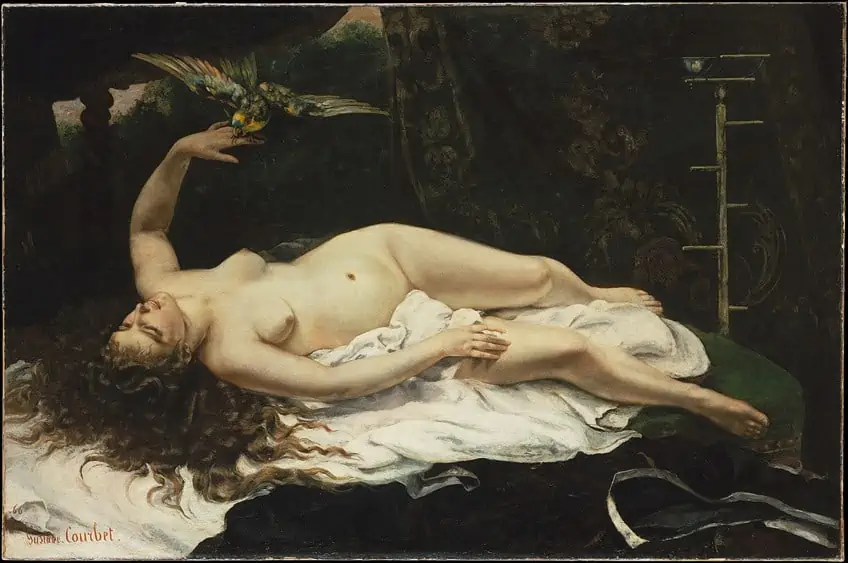
The parrot became one of the Virgin’s numerous attributes as a consequence of some strange convoluted medieval reasoning (the call of some parrots was considered to mirror the phrase “Ave” spoken by the angel Gabriel to greet Mary during the Annunciation). By connection, the bird began to be associated with women as a spiritual partner. Their opulent and exotic look and origin (and the resulting price of acquiring one) heightened their allusive usage as a reference to those characteristics in the sitter by certain painters.
By the 18th century, a caged bird had been linked with a fallen lady. As a result, the parrot came to represent both the erotic and the exotic.
The Dance Class (1874) by Edgar Degas
| Artist | Edgar Degas (1834 – 1917) |
| Date | 1874 |
| Medium | Oil on canvas |
| Dimensions (cm) | 83 cm x 77 cm |
The feminine elegance of the ballet dancer series has captivated many members of the art audience who believe that women are underrepresented in art. Edgar Degas’s enormous number of Ballerina pencil drawings and oil paintings allowed the artist to genuinely explore various stances, clothes, and locations, utilizing both single dancers and groups of dancers to generate varied effects.
Degas was a talented painter who was able to experiment with many art mediums, allowing him to try out ballerina scenarios in his pencil drawings and full-size deep oil canvases.
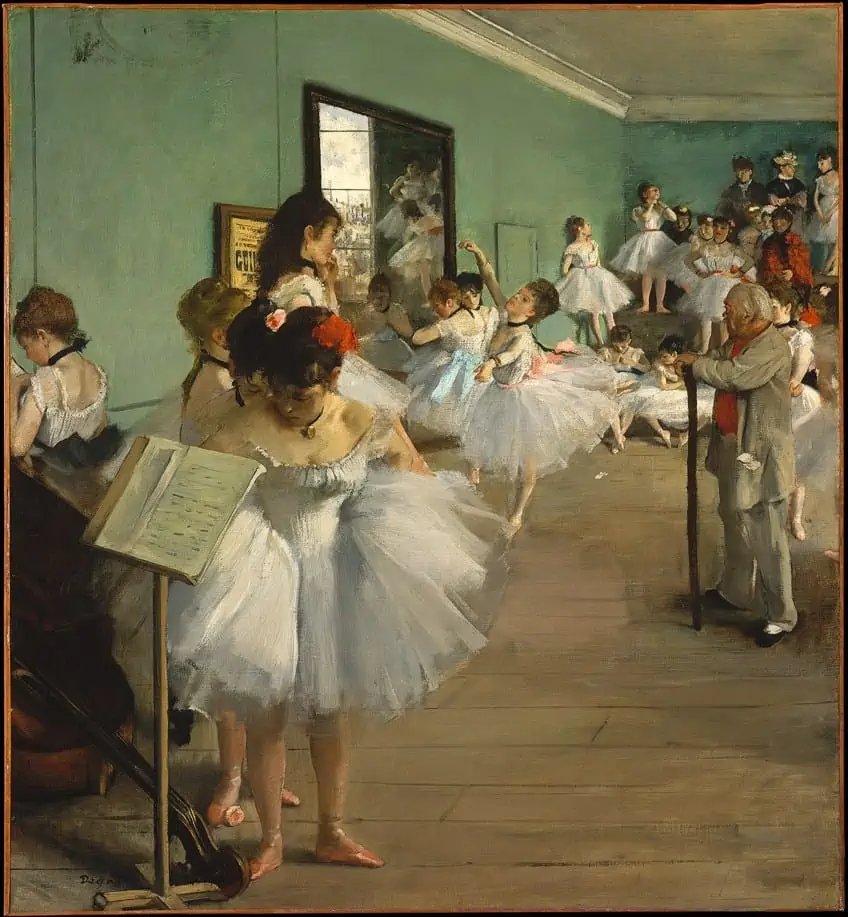
Jean-Baptiste Faure, who commissioned the artwork, loaned it to the 1876 Impressionist exhibition. Faure was a popular musician who appears in Rossini’s Guillaume Tell poster, which hangs next to the mirror. Edgar Degas prepared for these commissioned paintings by creating meticulous study sketches. Before starting this project, he first drew many dancers in his studio.
Edgar Degas was trained in classical art by artists such as Ingres, and his ability to capture ballerinas so sweetly and precisely demonstrates his unique aesthetic grasp of the human figure.
Self Portrait with Straw Hat (1887) by Vincent van Gogh
| Artist | Vincent van Gogh (1853 – 1890) |
| Date | 1887 |
| Medium | Oil on canvas |
| Dimensions (cm) | 41 cm x 33 cm |
Vincent Van Gogh created almost 20 self-portraits of himself, but don’t dismiss him as the world’s largest narcissist just yet. Because models were pricy, many painters used themselves as subjects to study with. This picture is deceptively basic in form, yet it is a great example of Vincent van Gogh’s abilities with color and his passion as an artist.
The artwork has a dynamic, vibrant aspect due to hundreds of small paint strokes, and the basic contrasted color schemes enable Van Gogh’s imagery to explode off the canvas.
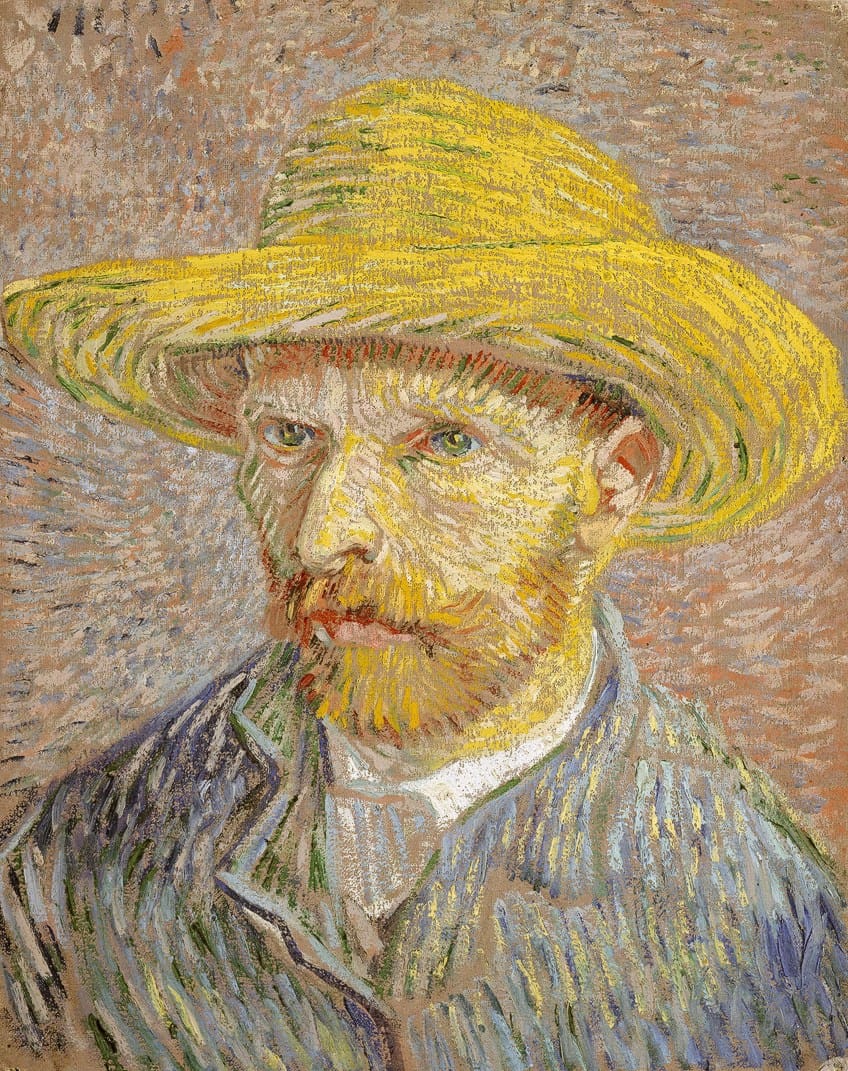
The bright palette and straw hat allude to the summer days and rural scenes that Van Gogh was obsessed with during his brief life. Many people are unaware that there is another artwork on the opposite side of the canvas. In 1885, Van Gogh created the Potato Peeler, which depicts a poor farm worker peeling potatoes. In 1887, he portrayed himself in a straw hat on the other side of the canvas. Van Gogh’s intention, while painting from a mirror, was not to create a lifelike portrait.
“Painted portraiture has a spirit of its own that comes from deep within the heart of the artist and where the camera can’t reach”, he once said.
The Gulf Stream (1899) by Winslow Homer
| Artist | Winslow Homer (1836 – 1910) |
| Date | 1899 |
| Medium | Oil on canvas |
| Dimensions (cm) | 71 cm x 124 cm |
Homer traversed the Gulf Stream multiple times, and his first voyage to the Caribbean in 1885 appears to have influenced several pieces dated that year. A trip to Florida and Nassau from December 1898 to February 1899 immediately preceded the completion of the artwork. By September 1899, Homer had begun work on the painting, writing, “I worked with watercolors for three months last winter and have now just begun composing a painting from some of the works”.
The artwork was displayed at the National Academy of Design in 1906, and all of the institution’s jury members urged the Metropolitan Museum of Art to buy the picture.
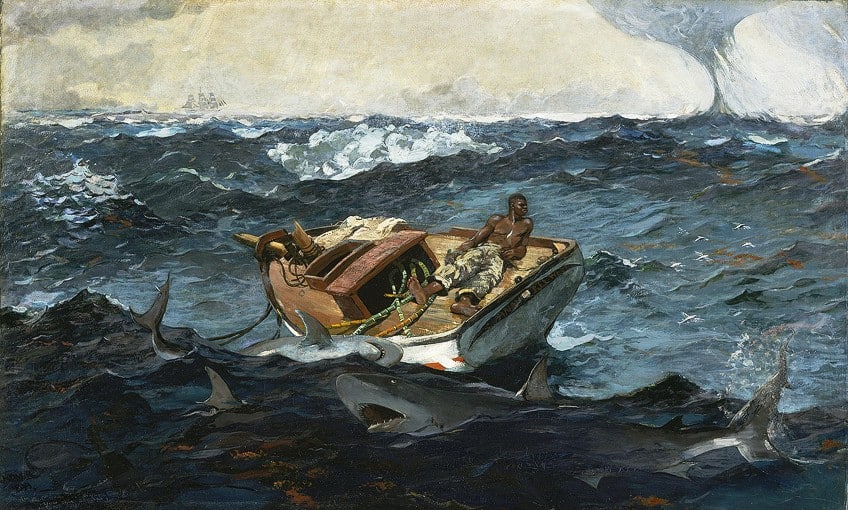
The work received mixed reactions in the press, with some describing it as more theatrical than Homer’s customary work. A Philadelphia reviewer remarked that onlookers had chuckled at the artwork, dubbed “Smiling Sharks”, characterizing the subject as “a nude negro resting in a boat as sharks dance around him in the most absurd fashion”.
The picture has been regarded as a particularly cryptic and fascinating event, a marine mystery that hovers in an area of unanswered mysteries indefinitely.
Bridge of a Pond of Water Lilies (1899) by Claude Monet
| Artist | Claude Monet (1840 – 1926) |
| Date | 1899 |
| Medium | Oil on canvas |
| Dimensions (cm) | 92 cm x 73 cm |
Monet, known to be an avid gardener, acquired land with a pond near his Giverny home in 1893, aiming to construct something “for the delight of the sight and also for themes to paint”. His water-lily garden was the end outcome. In 1899, he started a series of 18 paintings of the wooden footbridge across the pond, finishing 12 canvases that summer, including this one.
The vertical aspect of the image, which is rare in this series, emphasizes the water lilies and their reflection on the water of the pond.
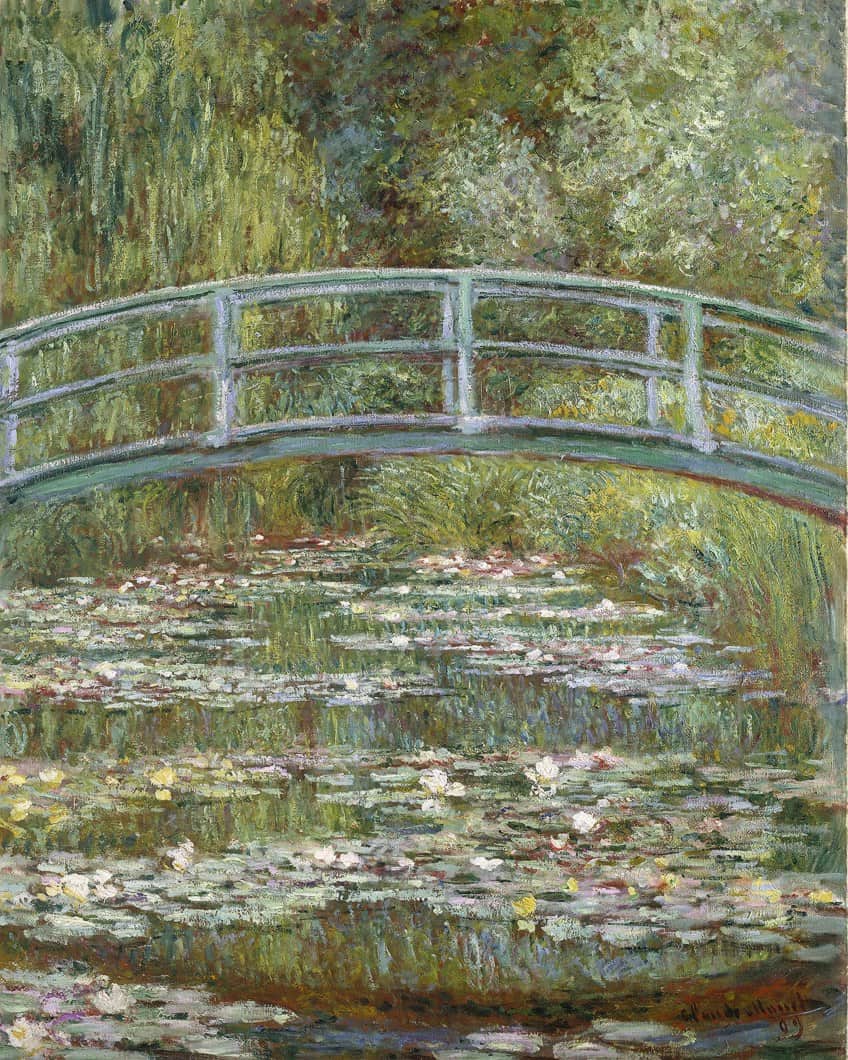
It also shows Monet at the pinnacle of his skill. Despite the simplicity of the subject, the artist captures the subtle color contrasts between the pink lilies and the green vegetation hanging over the lake. The bridge seems to float just above the water, similar to the water lilies that adorn the surface below.
Monet suggests a harmonious interaction between the organic and the man-made by utilizing the same green palette he employs for the trees and plants around the bridge.
Young Mother Sewing (1900) by Mary Cassatt
| Artist | Mary Cassatt (1844 – 1926) |
| Date | 1900 |
| Medium | Oil on canvas |
| Dimensions (cm) | 92 cm x 73 cm |
Mary Cassatt was a groundbreaking female artist of the late 19th century. Women were not encouraged to pursue careers as painters at that time. She devoted her energy near the end of the 19th century to portraying mothers caring for children as well as children alone.
Cassatt used two unconnected figures to play the roles of daughter and mother in this painting.
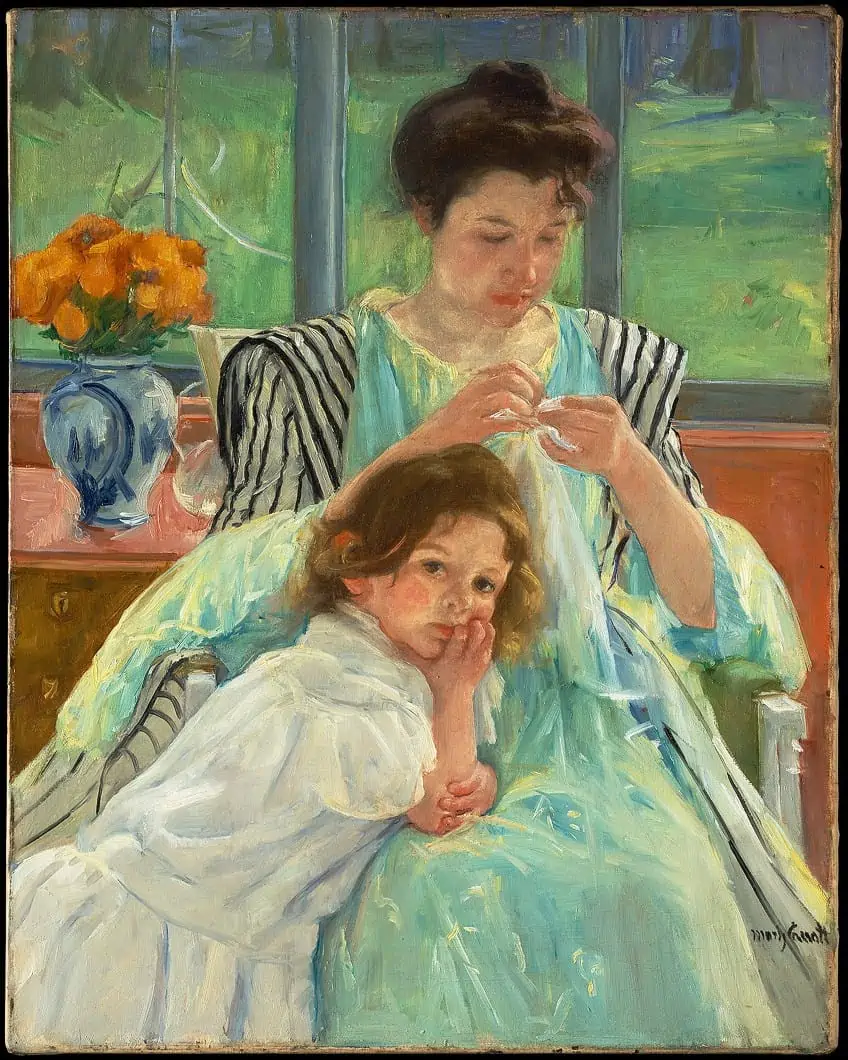
There is something exceedingly delicate and adorable for many fathers when they watch a young mother and youngster together. The commonplace may often provide a sense of familiarity with an event we’ve all had. The simple experience these two people are sharing has been shared by millions of women throughout history.
Cassatt portrays that wonderfully here.
Portrait of Gertrude Stein (1906) by Pablo Picasso
| Artist | Pablo Picasso (1881 – 1973) |
| Date | 1906 |
| Medium | Oil on canvas |
| Dimensions (cm) | 100 cm x 81 cm |
Picasso finally finished his first picture of Gertrude Stein, which he had begun not shortly after his first encounter with the American author, on his departure to Paris from Gosol in the fall of 1905. She sat for him some 80 or 90 times, according to Gertrude Stein, until he deserted it the following season, incomplete, by which time she had become his most significant private supporter.
Although sections of the picture were heavily revised, there is evidence to believe that Stein grossly inflated the number of posing sessions, probably to approach the sittings Ambroise Vollard said he experienced when Paul Cezanne created his portrait in 1899.
Whatever the reality is, Picasso’s painting of her is a gripping and engaging characterization, as well as a homage to her importance to him at this pivotal juncture in his career. Stein had a fearsome appearance – strong features, short, solid, and hefty – as well as a forceful demeanor.
Picasso desired to imply the strength of her character and brain as well as define her intriguing image in portraying her, and her definition of his posture as he painted suggests his almost zealous focus: she sat on a sizable damaged armchair in the Bateau Lavoir workshop while he was seated very snugly on a tiny wooden stool and very near to his canvas, clutching a rather small palette.
But the more he painted her, the more difficult it got to strike the proper balance between a recording of her physical look and a perceptive, significant depiction of her personality.
No. 13 (White, Red On Yellow) (1958) by Mark Rothko
| Artist | Mark Rothko (1903 – 1970) |
| Date | 1958 |
| Medium | Oil and acrylic with powdered pigments on canvas |
| Dimensions (cm) | 241 cm x 206 cm |
Color varies considerably throughout Rothko’s work and elicits a wide spectrum of emotions. This artwork’s primary colors of red and yellow are bright and joyful, but other works are comprised of dark, gloomy blues, maroons, and greens. The artist created a big series of somber works in the two years leading up to his suicide in 1970, most of which were done on paper using acrylics.
These works, composed of opaque, monochrome browns, grays, and blacks, are often simpler in design and lack the drifting aspect that formerly energized paintings such as this renowned masterpiece.
Abstract Expressionism, a popular painting style in the 1950s, comprises two quite distinct mindsets. The first, exemplified by the work of Willem de Kooning and Jackson Pollock, is distinguished by energized brushstrokes and repetitive, vibrant compositions; the second, embodied by Mark Rothko’s works of art, is introspective in tone and composed of subtle shading harmonies, largely constant compositions, and simplified forms. By 1950, Rothko had devised the compositional format that he would employ for the remainder of his life, with improvements and alterations. Shape and color replace typical narrative substance and figurative imagery in these purely abstract compositions.
And with that, we have come to the end of our list of famous paintings at The Met. Met art constitutes some of the most renowned artworks ever created, so having this guide of works that are regarded as a must-see at The Met will help you decide what to view if you ever manage to visit this incredible establishment. Can you imagine seeing the Metropolitan Museum of Art’s artworks in person? That is not always a possibility for many people, so once you are done reading about these paintings in the Metropolitan Museum of Art, why not go online and see some of The Met Museum highlights for yourself?
Frequently Asked Questions
What Is The Met Museum Famous For?
There are countless paintings in the Metropolitan Museum of Art that have made it one of the world’s most popular museums. In fact, there are more than two million Met artworks on display! If you can, go view the Metropolitan Museum of Art artworks for yourself, and you will see why it is so well loved.
What Famous Pieces of Art Are at The Met Museum?
There are simply too many to mention, but this article has named a few select Met artworks for you to check out. Or if you are ever in New York, do yourself a favor and see them in person. Met Museum highlights can also be found online. We recommend Vincent van Gogh’s Self Portrait in a Straw Hat (1887) and Bridge of a Pond of Water Lilies (1920) by Claude Monet. Enjoy the search!
Jordan Anthony is a Cape Town-based film photographer, curator, and arts writer. She holds a Bachelor of Art in Fine Arts from the University of the Witwatersrand, Johannesburg, where she explored themes like healing, identity, dreams, and intuitive creation in her Contemporary art practice. Jordan has collaborated with various local art institutions, including the KZNSA Gallery in Durban, the Turbine Art Fair, and the Wits Art Museum. Her photography focuses on abstract color manipulations, portraiture, candid shots, and urban landscapes. She’s intrigued by philosophy, memory, and esotericism, drawing inspiration from Surrealism, Fluxus, and ancient civilizations, as well as childhood influences and found objects. Jordan is working for artfilemagazine since 2022 and writes blog posts about art history and photography.
Learn more about Jordan Anthony and about us.
Cite this Article
Jordan, Anthony, “Famous Paintings at The Met – The Top Met Museum Highlights.” artfilemagazine – Your Online Art Source. November 17, 2022. URL: https://artfilemagazine.com/famous-paintings-at-the-met/
Anthony, J. (2022, 17 November). Famous Paintings at The Met – The Top Met Museum Highlights. artfilemagazine – Your Online Art Source. https://artfilemagazine.com/famous-paintings-at-the-met/
Anthony, Jordan. “Famous Paintings at The Met – The Top Met Museum Highlights.” artfilemagazine – Your Online Art Source, November 17, 2022. https://artfilemagazine.com/famous-paintings-at-the-met/.



